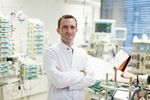Generation of hematopoietic stem and progenitor cells from human pluripotent stem cells in vitro
Martina Cremanns
For lifetime success of somatic gene therapy of the hematopoietic system, hematopoietic stem cells (HSCs) are the key target cells.
Human multipotent HSCs reside within the CD133+CD34+CD45RA-fraction, which can be isolated from umbilical cord blood, bone marrow or, after mobilization, from peripheral blood (Görgens et al.; 2013). However, these cells are very limited in number and their expansion or even maintenance, in vitro, has not been accomplished so far (Radtke et al., 2016).
In contrast to multipotent cells, pluripotent stem cells (PSCs), such as Embryonic Stem Cells (ESCs) or induced Pluripotent Stem Cells (iPSCs), can be expanded efficiently without loss of their stem cell properties. Furthermore, they can differentiate into all cell types of the three germ layers including hematopoietic stem cells, a process which is promoted by the ectopic expression of the human homeodomain transcription factor HOXB4 (Sauvageau et al., 1995; Klump et al., 2001; Schiedlmeier et al., 2003).
By using pluripotent cells, our aim is to understand key molecular processes controlling HSC development. Particularly, we focus on the specification of the hemogenic endothelium, which appears to develop from a common progenitor of endothelial cells and HSCs. Using this in vitro system, we are also trying to understand how endothelial and hematopoietic lineages are separated from each other during development.
The long-term goal of this work is to contribute a better understanding of the underlying molecular mechanisms which can be expected to pave the way for the de novo generation and selective expansion of human HSCs in future.






